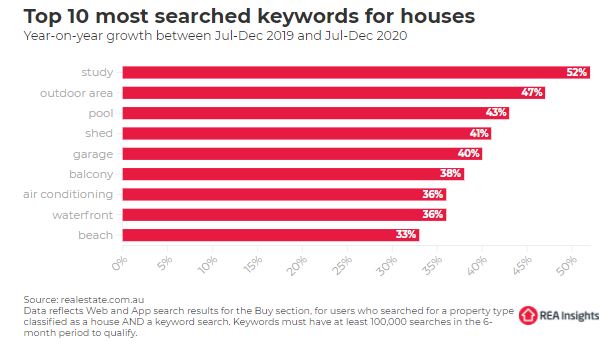Anyone who has juggled working from home, home schooling and family meal time in the same space during COVID-19 knows firsthand how the pandemic has changed what Australians need in their home.
While people are generally seeking more space and flexibility in their homes, the pandemic-enforced shift to working from home is having the biggest – and perhaps lasting – impact on housing.
A home office is now the must-have for many home buyers, with ‘study’ the most searched keyword from buyers looking for houses on realestate.com.au in the second half of 2020.
 Earlier in the pandemic, outdoor space was front of mind for house hunters.
Earlier in the pandemic, outdoor space was front of mind for house hunters.
Executive manager of economic research at realestate.com.au Cameron Kusher said the rapid adoption of working from home in 2020 and its continuation are having repercussions for the housing market.
“There will be an expectation from employees that flexible working arrangements will become more normal while others will have no need to be in an office going forward,” Mr Kusher said.
“This has resulted in repercussions for the housing market with people more inclined to look for regional properties and people being more focused on having additional bedrooms and studies so they can easily work from home moving forward.
“Of course these additional amenities and rooms in a home come at a cost so that may also be a key consideration for buyers who are choosing to purchase in relatively more affordable areas of the country so they can get more home for less.”
“It has made a lot of people think that their home is not necessarily as much of a sleeping quarters to the degree as it was before,” Mr James said.
“People are definitely seeing that their home is now very important, and their surroundings.”
Dr Sing D’Arcy, senior lecturer at UNSW Built Environment, said extended lockdowns during the once-in-a-century pandemic had changed people’s normal pattern of living.
“You start to go: ‘Oh, right, what is this space that I’m living in now that I’ve got to live within these walls 24 hours a day for three months’,” he said.
A place to work from home is essential
Working from home has elevated the importance of a space to do the work.
“People definitely will want places to work, that’s a given,” Mr James said.
“A study is pretty much imperative to all projects at this point in time.”
Dr D’Arcy said a single person in a one-bedroom apartment could conduct meetings and organise a working space, but it was more challenging for two people trying to work from home and participate in virtual meetings in the living space while children undertake remote learning.
“That’s when we really need to think about how we can better design our living spaces to enable us to have some form of acoustic separation or even just a mental space within our own home where we can do our work,” he said.
When a number of people had to set up their computers on the dining table, Dr D’Arcy said the issue was what happened at the end of the working day.
“What happens at five o’clock? Is everybody prepared to pack everything up to turn it back into a home or do you really start to be living in your office?”
Having a separate study may be the ideal, but Dr D’Arcy said it was not financially possible for everyone.
He suggested one of the solutions may be to borrow from contemporary ideas of workplace design to accommodate the presence of work at home, using the lessons learnt from activity-based working that allows multiple functions and zones on a floor plan.
“It could be, for example, a specific type of furniture that has a high back and high sides so there’s no visual interference and the noise is reduced. That would be perfect for having a quick Zoom meeting without necessarily building a studio or a granny flat out the back.”
Will COVID lead to lasting design changes?
Architects, developers and academics are pondering what impact the pandemic will have on the long-term design of houses and apartments.
“The lasting changes on home design – if they are lasting – are basically going to be that the house is a place that you might not leave quite as much,” Mr James said.
“People will be wanting the designs to match their lifestyle.”
Mr James said COVID had changed future thinking away from higher-density development in the city, where people live above shops and work down the street.
“At this point in time we’ve done a little bit of a 180-degree turn away from this high-density living.
“What is happening within your boundary – whether it be party walls in a townhouse or an apartment building or whether it be the boundary of your block – I think is far more important now than what it was before.”
Dr D’Arcy said the new paradigm of working and how people work will have longer-term impacts on house design, but noted that such changes often took a long time and successful COVID vaccines could mean life – and homes – returned to normal.
“There might be more immediate, simple changes that people can do in the upgrades of bathrooms and kitchens and other types of spaces, more so than a future COVID-safe house,” he said.
Dr D’Arcy said people may think about putting sensor taps or toilet switches in shared bathrooms in large households. He also had another suggestion in the wake of toilet paper panic buying.
“Australians always used to laugh at the whole notion of a bidet when they went to Europe and the same thing with the automated toilets in Japan.
“But suddenly people think ‘oh, actually I don’t have to worry about toilet paper if I upgrade my toilet to a smart toilet.”
Source: https://www.realestate.com.au/news/post-covid-living-how-wfh-has-changed-what-buyers-want-in-a-home/



